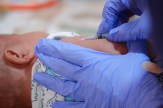Could safeguarding firearms reduce the number of suicides?

The rate of U.S. suicides has been rising for the past decade. Fewer people died from traffic accidents or murders in 2018 than from suicide, which claimed 48,344 lives, according to the Centers for Disease Control and Prevention.
This curve can be flattened and reversed, says Northeastern professor Matt Miller. His latest research offers one approach by demonstrating that hospital clinicians who provide simple information on gun safety can change behaviors and ultimately save lives.
At the heart of this work is Miller’s premise that much more can and should be done to mitigate suicides, starting with the safeguarding of firearms.
“There are many laudable efforts being made to reduce the emotional, psychic, and existential suffering of people,” Miller says. “But that’s not the only way to prevent suicide. A second way is to make it harder for people to die from the attempt. And there’s nothing that we can do here in the United States that is more effective at preventing that act becoming lethal than removing the gun from the home, or otherwise making it inaccessible to the person at risk.”

The two-year study focused on seven hospital emergency departments in Colorado that admitted children (aged 10 to 17) who had attempted suicide, were considering suicide, or were otherwise in distress. Behavioral health clinicians at the Colorado hospitals were provided with brief training that focused on locking away guns and medications in order to prevent suicides.
After the emergency clinicians were trained, parents of at-risk children were more than twice as likely to store guns and medications safely in their homes.
“Parents seemed much more likely to store their guns and medications safely after being exposed to the intervention,” says Miller, a professor of health sciences and epidemiology who has been researching injury and violence prevention for two decades.
For every suicide in the U.S., there are at least nine attempts that do not result in death. Among those distressed people who resort to taking pills or cutting themselves, only two to three percent of the attempts end in death, says Miller.
He believes that a large number of suicides could be thwarted by keeping vulnerable people away from guns. For those who attempt suicide with a firearm, the death rate is greater than 90 percent.
“You pull the trigger, and usually you don’t get a second chance,” Miller says. “So you can save lives by making it harder for people to get their hands on a gun.”
The national suicide rate among young people (aged 10 to 24) has risen by more than half, the CDC reports. And yet, Miller’s research has shown fewer than 10 percent of gun owners with children believe that keeping firearms in the home increases the risk of suicide.
Over the course of his own lifetime, Miller has seen a sea change in public opinions about drunk driving. Someday, he says, he hopes that a version of the one-hour training video that was shown to Colorado clinicians could be produced for the general public, and that brief public service announcements on taking measures to reduce suicide will become commonplace.
“I hope that this study serves as motivation for emergency departments around the country to adopt the protocol that has become standard practice at all of the Colorado hospitals,” Miller says. “It would be great if the same kinds of training and resources were available everywhere.”
In the meantime, small changes in behavior can produce meaningful results. Another study by Miller has shown that gun deaths among young people—the majority of them suicides—could be decreased by almost one-third if just 20 percent more gun owners locked up their firearms.
“The information that we think the clinicians and the parents need to know is that guns put their kids at three or four times higher risk of dying by suicide,” says Miller, who co-authored the report with Carmel Salhi, an assistant professor at Northeastern.
Salhi will soon be publishing qualitative investigations from the study, a collaboration between Northeastern, Harvard, Colorado Medical School, and Colorado School of Public Health. It is the first controlled study of high-risk patients who received lethal-means counseling in emergency departments, and Miller is looking forward to unpacking its components.
“We really try to emphasize removing the guns from the home,” Miller says. “Although most parents didn’t do that. Most parents who changed their storage practices for the better did so by locking away their previously unlocked guns.”
For media inquiries, please contact Shannon Nargi at s.nargi@northeastern.edu or 617-373-5718.






